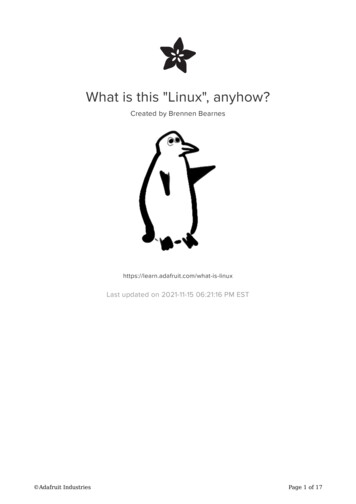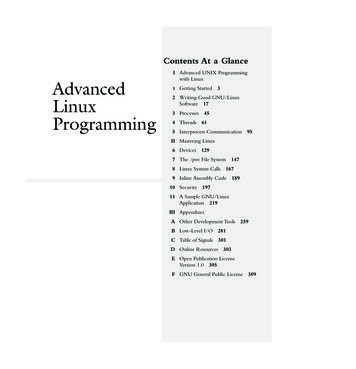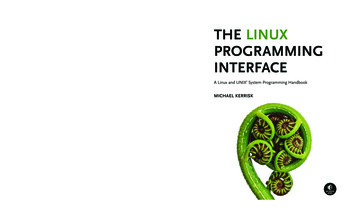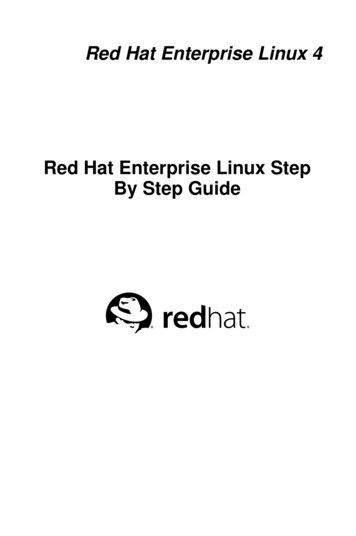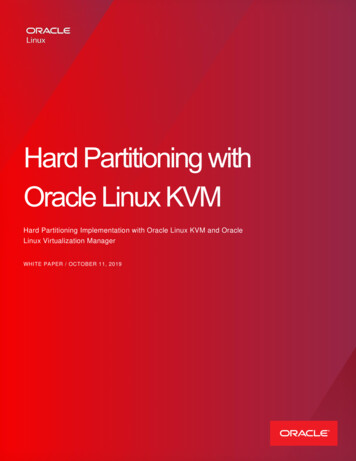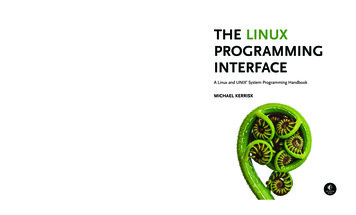
Transcription
The definitive guide to Linuxand UNIX system programming fffRead and write files efficientlyUse signals, clocks, and timersCreate processes and execute programsfffffWrite secure programsWrite multithreaded programs using POSIX threadsBuild and use shared librariesPerform interprocess communication using pipes,message queues, shared memory, and semaphoresWrite network applications with the sockets APIWhile The Linux Programming Interface covers a wealthof Linux-specific features, including epoll, inotify, andthe /proc file system, its emphasis on UNIX standards(POSIX.1-2001/SUSv3 and POSIX.1-2008/SUSv4)makes it equally valuable to programmers working onother UNIX platforms.The Linux Programming Interface is the most comprehensive single-volume work on the Linux and UNIXprogramming interface, and a book that’s destined tobecome a new classic.About the AuthorMichael Kerrisk (http://man7.org/) has been using and programming UNIX systemsfor more than 20 years, and has taught many week-long courses on UNIX systemprogramming. Since 2004, he has maintained the man-pages project, whichproduces the manual pages describing the Linux kernel and glibc programmingAPIs. He has written or cowritten more than 250 of the manual pages and is activelyinvolved in the testing and design review of new Linux kernel-userspace interfaces.Michael lives with his family in Munich, Germany.Covers current UNIX standards (POSIX.1-2001/SUSv3 and POSIX.1-2008/SUSv4)T H E F I N E ST I N G E E K E N T E RTA I N M E N T w w w.nostarch.com 99.95 ( 114.95 CDN )KerriskShelve In: linux/programmingISBN: 978-1-59327-220-35 999 59 781593 272203This logo applies only to the text stock.689145 72200The LinuxProgrammingInterfaceThe Linux Programming Interface is the definitive guideto the Linux and UNIX programming interface—theinterface employed by nearly every application thatruns on a Linux or UNIX system.In this authoritative work, Linux programmingexpert Michael Kerrisk provides detailed descriptionsof the system calls and library functions that you needin order to master the craft of system programming,and accompanies his explanations with clear, completeexample programs.You’ll find descriptions of over 500 system callsand library functions, and more than 200 example programs, 88 tables, and 115 diagrams. You’ll learn how to:0The LinuxProgrammingInterfaceA Linux and UNIX System Programming Handbook Michael Kerrisk
PROCESS CREATIONIn this and the next four chapters, we look at how a process is created and terminates, and how a process can execute a new program. This chapter covers processcreation. However, before diving into that subject, we present a short overview ofthe main system calls covered in these chapters.24.1Overview of fork(), exit(), wait(), and execve()The principal topics of this and the next few chapters are the system calls fork(),exit(), wait(), and execve(). Each of these system calls has variants, which we’ll alsolook at. For now, we provide an overview of these four system calls and how theyare typically used together. The fork() system call allows one process, the parent, to create a new process,the child. This is done by making the new child process an (almost) exact duplicate of the parent: the child obtains copies of the parent’s stack, data, heap,and text segments (Section 6.3). The term fork derives from the fact that we canenvisage the parent process as dividing to yield two copies of itself.The exit(status) library function terminates a process, making all resources(memory, open file descriptors, and so on) used by the process available forsubsequent reallocation by the kernel. The status argument is an integer thatdetermines the termination status for the process. Using the wait() system call,the parent can retrieve this status.The Linux Programming Interface 2010 by Michael Kerriskhttp://www.nostarch.com/tlpi
The exit() library function is layered on top of the exit() system call. In Chapter 25,we explain the difference between the two interfaces. In the meantime, we’lljust note that, after a fork(), generally only one of the parent and child terminate by calling exit(); the other process should terminate using exit(). The wait(&status) system call has two purposes. First, if a child of this processhas not yet terminated by calling exit(), then wait() suspends execution of theprocess until one of its children has terminated. Second, the termination statusof the child is returned in the status argument of wait().The execve(pathname, argv, envp) system call loads a new program (pathname,with argument list argv, and environment list envp) into a process’s memory.The existing program text is discarded, and the stack, data, and heap segmentsare freshly created for the new program. This operation is often referred to asexecing a new program. Later, we’ll see that several library functions are layeredon top of execve(), each of which provides a useful variation in the programming interface. Where we don’t care about these interface variations, we followthe common convention of referring to these calls generically as exec(), but beaware that there is no system call or library function with this name.Some other operating systems combine the functionality of fork() and exec() into asingle operation—a so-called spawn—that creates a new process that then executes aspecified program. By comparison, the UNIX approach is usually simpler andmore elegant. Separating these two steps makes the APIs simpler (the fork() systemcall takes no arguments) and allows a program a great degree of flexibility in theactions it performs between the two steps. Moreover, it is often useful to perform afork() without a following exec().SUSv3 specifies the optional posix spawn() function, which combines the effectof fork() and exec(). This function, and several related APIs specified by SUSv3,are implemented on Linux in glibc. SUSv3 specifies posix spawn() to permitportable applications to be written for hardware architectures that don’t provide swap facilities or memory-management units (this is typical of manyembedded systems). On such architectures, a traditional fork() is difficult orimpossible to implement.Figure 24-1 provides an overview of how fork(), exit(), wait(), and execve() are commonly used together. (This diagram outlines the steps taken by the shell in executinga command: the shell continuously executes a loop that reads a command, performsvarious processing on it, and then forks a child process to exec the command.)The use of execve() shown in this diagram is optional. Sometimes, it is insteaduseful to have the child carry on executing the same program as the parent. In eithercase, the execution of the child is ultimately terminated by a call to exit() (or bydelivery of a signal), yielding a termination status that the parent can obtain via wait().The call to wait() is likewise optional. The parent can simply ignore its childand continue executing. However, we’ll see later that the use of wait() is usuallydesirable, and is often employed within a handler for the SIGCHLD signal, which thekernel generates for a parent process when one of its children terminates. (Bydefault, SIGCHLD is ignored, which is why we label it as being optionally delivered inthe diagram.)514Chapter 24The Linux Programming Interface 2010 by Michael Kerriskhttp://www.nostarch.com/tlpi
Parent processrunning program “A”AChild processrunning program “A”fork()Memory ofparentcopiedto childParent may performother actions hereAChild may performfurther actions herewait(&status)(optional)execve(B, .)(optional)Execution of parentsuspendedpa Chiss lded stto atupa srentKernel restarts parent andoptionally delivers SIGCHLDBExecution ofprogram “B”exit(status)Figure 24-1: Overview of the use of fork(), exit(), wait(), and execve()24.2Creating a New Process: fork()In many applications, creating multiple processes can be a useful way of dividingup a task. For example, a network server process may listen for incoming clientrequests and create a new child process to handle each request; meanwhile, theserver process continues to listen for further client connections. Dividing tasks upin this way often makes application design simpler. It also permits greater concurrency (i.e., more tasks or requests can be handled simultaneously).The fork() system call creates a new process, the child, which is an almost exactduplicate of the calling process, the parent.The Linux Programming Interface 2010 by Michael Kerriskhttp://www.nostarch.com/tlpiP r o c e ss C r e a t io n515
#include unistd.h pid t fork(void);In parent: returns process ID of child on success, or –1 on error;in successfully created child: always returns 0The key point to understanding fork() is to realize that after it has completed itswork, two processes exist, and, in each process, execution continues from the pointwhere fork() returns.The two processes are executing the same program text, but they have separatecopies of the stack, data, and heap segments. The child’s stack, data, and heap segments are initially exact duplicates of the corresponding parts of the parent’s memory. After the fork(), each process can modify the variables in its stack, data, andheap segments without affecting the other process.Within the code of a program, we can distinguish the two processes via thevalue returned from fork(). For the parent, fork() returns the process ID of thenewly created child. This is useful because the parent may create, and thus need totrack, several children (via wait() or one of its relatives). For the child, fork() returns 0.If necessary, the child can obtain its own process ID using getpid(), and the processID of its parent using getppid().If a new process can’t be created, fork() returns –1. Possible reasons for failureare that the resource limit (RLIMIT NPROC, described in Section 36.3) on the number ofprocesses permitted to this (real) user ID has been exceeded or that the systemwide limit on the number of processes that can be created has been reached.The following idiom is sometimes employed when calling fork():pid t childPid;/* Used in parent after successful fork()to record PID of child */switch (childPid fork()) {case -1:/* fork() failed *//* Handle error */case 0:/* Child of successful fork() comes here *//* Perform actions specific to child */default:/* Parent comes here after successful fork() *//* Perform actions specific to parent */}It is important to realize that after a fork(), it is indeterminate which of the twoprocesses is next scheduled to use the CPU. In poorly written programs, this indeterminacy can lead to errors known as race conditions, which we describe further inSection 24.4.Listing 24-1 demonstrates the use of fork(). This program creates a child thatmodifies the copies of global and automatic variables that it inherits during thefork().The use of sleep() (in the code executed by the parent) in this program permitsthe child to be scheduled for the CPU before the parent, so that the child can complete its work and terminate before the parent continues execution. Using sleep() in516Chapter 24The Linux Programming Interface 2010 by Michael Kerriskhttp://www.nostarch.com/tlpi
this manner is not a foolproof method of guaranteeing this result; we look at a bettermethod in Section 24.5.When we run the program in Listing 24-1, we see the following output: ./t forkPID 28557 (child) idata 333 istack 666PID 28556 (parent) idata 111 istack 222The above output demonstrates that the child process gets its own copy of the stackand data segments at the time of the fork(), and it is able to modify variables inthese segments without affecting the parent.Listing 24-1: Using –––––––– procexec/t fork.c#include "tlpi hdr.h"static int idata 111;/* Allocated in data segment */intmain(int argc, char *argv[]){int istack 222;pid t childPid;/* Allocated in stack segment */switch (childPid fork()) {case -1:errExit("fork");case 0:idata * 3;istack * 3;break;default:sleep(3);break;}/* Give child a chance to execute *//* Both parent and child come here */printf("PID %ld %s idata %d istack %d\n", (long) getpid(),(childPid 0) ? "(child) " : "(parent)", idata, istack);exit(EXIT �––––––––– procexec/t fork.c24.2.1File Sharing Between Parent and ChildWhen a fork() is performed, the child receives duplicates of all of the parent’s filedescriptors. The duplicated file descriptors in the child refer to the same open filedescriptions as the corresponding descriptors in the parent. As we saw inSection 5.4, the open file description contains the current file offset (as modifiedThe Linux Programming Interface 2010 by Michael Kerriskhttp://www.nostarch.com/tlpiP r o c e ss C r e a t io n517
by read(), write(), and lseek()) and the open file status flags (set by open() andchanged by the fcntl() F SETFL operation). Consequently, these attributes of an openfile are shared between the parent and child. For example, if the child updates thefile offset, this change is visible through the corresponding descriptor in the parent.The fact that these attributes are shared by the parent and child after a fork() isdemonstrated by the program in Listing 24-2. This program opens a temporary fileusing mkstemp(), and then calls fork() to create a child process. The child changesthe file offset and open file status flags of the temporary file, and exits. The parentthen retrieves the file offset and flags to verify that it can see the changes made bythe child. When we run the program, we see the following: ./fork file sharingFile offset before fork(): 0O APPEND flag before fork() is: offChild has exitedFile offset in parent: 1000O APPEND flag in parent is: onFor an explanation of why we cast the return value from lseek() to long long inListing 24-2, see Section 5.10.Listing 24-2: Sharing of file offset and open file status flags between parent and �––––––––––––––– procexec/fork file sharing.c#include#include#include#include sys/stat.h fcntl.h sys/wait.h "tlpi hdr.h"intmain(int argc, char *argv[]){int fd, flags;char template[] "/tmp/testXXXXXX";setbuf(stdout, NULL);/* Disable buffering of stdout */fd mkstemp(template);if (fd -1)errExit("mkstemp");printf("File offset before fork(): %lld\n",(long long) lseek(fd, 0, SEEK CUR));flags fcntl(fd, F GETFL);if (flags -1)errExit("fcntl - F GETFL");printf("O APPEND flag before fork() is: %s\n",(flags & O APPEND) ? "on" : "off");518Chapter 24The Linux Programming Interface 2010 by Michael Kerriskhttp://www.nostarch.com/tlpi
switch (fork()) {case -1:errExit("fork");case 0:/* Child: change file offset and status flags */if (lseek(fd, 1000, SEEK SET) -1)errExit("lseek");flags fcntl(fd, F GETFL);/* Fetch current flags */if (flags -1)errExit("fcntl - F GETFL");flags O APPEND;/* Turn O APPEND on */if (fcntl(fd, F SETFL, flags) -1)errExit("fcntl - F SETFL");exit(EXIT SUCCESS);default:/* Parent: can see file changes made by child */if (wait(NULL) -1)errExit("wait");/* Wait for child exit */printf("Child has exited\n");printf("File offset in parent: %lld\n",(long long) lseek(fd, 0, SEEK CUR));flags fcntl(fd, F GETFL);if (flags -1)errExit("fcntl - F GETFL");printf("O APPEND flag in parent is: %s\n",(flags & O APPEND) ? "on" : "off");exit(EXIT �� procexec/fork file sharing.cSharing of open file attributes between the parent and child processes is frequentlyuseful. For example, if the parent and child are both writing to a file, sharing thefile offset ensures that the two processes don’t overwrite each other’s output. Itdoes not, however, prevent the output of the two processes from being randomlyintermingled. If this is not desired, then some form of process synchronization isrequired. For example, the parent can use the wait() system call to pause until thechild has exited. This is what the shell does, so that it prints its prompt only afterthe child process executing a command has terminated (unless the user explicitlyruns the command in the background by placing an ampersand character at theend of the command).If sharing of open file attributes in this manner is not required, then an application should be designed so that, after a fork(), the parent and child use differentfile descriptors, with each process closing unused descriptors (i.e., those used bythe other process) immediately after forking. (If one of the processes performs anexec(), the close-on-exec flag described in Section 27.4 can also be useful.) Thesesteps are shown in Figure 24-2.The Linux Programming Interface 2010 by Michael Kerriskhttp://www.nostarch.com/tlpiP r o c e ss C r e a t io n519
a) Descriptors and openfile table entriesbefore fork()Parent file descriptors( close-on-exec flag )Open file table( file offset, status flags)descriptor xdescriptor yOFT entry mOFT entry nb) Descriptors afterfork()Parent file descriptorsdescriptor xdescriptor yDescriptorsduplicatedin childOpen file tableOFT entry mChild file descriptorsdescriptor xOFT entry ndescriptor yc) After closing unuseddescriptors in parent( y) and child (x)Parent file descriptorsOpen file tabledescriptor xdescriptor yOFT entry mChild file descriptorsdescriptor xOFT entry ndescriptor yFigure 24-2: Duplication of file descriptors during fork(), and closing of unused descriptors24.2.2Memory Semantics of fork()Conceptually, we can consider fork() as creating copies of the parent’s text, data,heap, and stack segments. (Indeed, in some early UNIX implementations, suchduplication was literally performed: a new process image was created by copying theparent’s memory to swap space, and making that swapped-out image the child process while the parent kept its own memory.) However, actually performing a simplecopy of the parent’s virtual memory pages into the new child process would bewasteful for a number of reasons—one being that a fork() is often followed by animmediate exec(), which replaces the process’s text with a new program and reinitializes520Chapter 24The Linux Programming Interface 2010 by Michael Kerriskhttp://www.nostarch.com/tlpi
the process’s data, heap, and stack segments. Most modern UNIX implementations, including Linux, use two techniques to avoid such wasteful copying: The kernel marks the text segment of each process as read-only, so that a process can’t modify its own code. This means that the parent and child can sharethe same text segment. The fork() system call creates a text segment for thechild by building a set of per-process page-table entries that refer to the samephysical memory page frames already used by the parent.For the pages in the data, heap, and stack segments of the parent process, thekernel employs a technique known as copy-on-write. (The implementation ofcopy-on-write is described in [Bach, 1986] and [Bovet & Cesati, 2005].) Initially,the kernel sets things up so that the page-table entries for these segments referto the same physical memory pages as the corresponding page-table entries inthe parent, and the pages themselves are marked read-only. After the fork(), thekernel traps any attempts by either the parent or the child to modify one ofthese pages, and makes a duplicate copy of the about-to-be-modified page. Thisnew page copy is assigned to the faulting process, and the corresponding pagetable entry for the other process is adjusted appropriately. From this point on,the parent and child can each modify their private copies of the page, withoutthe changes being visible to the other process. Figure 24-3 illustrates the copyon-write technique.Before modificationParentpage tableAfter modificationPhysical pageframesParentpage tablePT entry 211Childpage tablePhysical pageframesPT entry 211Frame1998UnusedpageframesChildpage tableFrame1998Frame2038PT entry 211PT entry 211Figure 24-3: Page tables before and after modification of a shared copy-on-write pageControlling a process’s memory footprintWe can combine the use of fork() and wait() to control the memory footprint of aprocess. The process’s memory footprint is the range of virtual memory pages usedby the process, as affected by factors such as the adjustment of the stack as functionsThe Linux Programming Interface 2010 by Michael Kerriskhttp://www.nostarch.com/tlpiP r o c e ss C r e a t io n521
are called and return, calls to exec(), and, of particular interest to this discussion,modification of the heap as a consequence of calls to malloc() and free().Suppose that we bracket a call to some function, func(), using fork() and wait()in the manner shown in Listing 24-3. After executing this code, we know that thememory footprint of the parent is unchanged from the point before func() wascalled, since all possible changes will have occurred in the child process. This canbe useful for the following reasons: If we know that func() causes memory leaks or excessive fragmentation of theheap, this technique eliminates the problem. (We might not otherwise be ableto deal with these problems if we don’t have access to the source code of func().)Suppose that we have some algorithm that performs memory allocation whiledoing a tree analysis (for example, a game program that analyzes a range ofpossible moves and their responses). We could code such a program to makecalls to free() to deallocate all of the allocated memory. However, in some cases,it is simpler to employ the technique we describe here in order to allow us tobacktrack, leaving the caller (the parent) with its original memory footprintunchanged.In the implementation shown in Listing 24-3, the result of func() must be expressedin the 8 bits that exit() passes from the terminating child to the parent calling wait().However, we could employ a file, a pipe, or some other interprocess communication technique to allow func() to return larger results.Listing 24-3: Calling a function without changing the process’s memory ––– from procexec/footprint.cpid t childPid;int status;childPid fork();if (childPid -1)errExit("fork");if (childPid 0)exit(func(arg));/* Child calls func() and *//* uses return value as exit status *//* Parent waits for child to terminate. It can determine theresult of func() by inspecting 'status'. */if (wait(&status) �–––––– from procexec/footprint.c24.3The vfork() System CallEarly BSD implementations were among those in which fork() performed a literalduplication of the parent’s data, heap, and stack. As noted earlier, this is wasteful, especially if the fork() is followed by an immediate exec(). For this reason, later versions ofBSD introduced the vfork() system call, which was far more efficient than BSD’s fork(),although it operated with slightly different (in fact, somewhat strange) semantics.522Chapter 24The Linux Programming Interface 2010 by Michael Kerriskhttp://www.nostarch.com/tlpi
Modern UNIX implementations employing copy-on-write for implementing fork() aremuch more efficient than older fork() implementations, thus largely eliminating theneed for vfork(). Nevertheless, Linux (like many other UNIX implementations) provides a vfork() system call with BSD semantics for programs that require the fastestpossible fork. However, because the unusual semantics of vfork() can lead to somesubtle program bugs, its use should normally be avoided, except in the rare caseswhere it provides worthwhile performance gains.Like fork(), vfork() is used by the calling process to create a new child process.However, vfork() is expressly designed to be used in programs where the child performs an immediate exec() call.#include unistd.h pid t vfork(void);In parent: returns process ID of child on success, or –1 on error;in successfully created child: always returns 0Two features distinguish the vfork() system call from fork() and make it more efficient: No duplication of virtual memory pages or page tables is done for the childprocess. Instead, the child shares the parent’s memory until it either performsa successful exec() or calls exit() to terminate.Execution of the parent process is suspended until the child has performed anexec() or exit().These points have some important implications. Since the child is using the parent’smemory, any changes made by the child to the data, heap, or stack segments will bevisible to the parent once it resumes. Furthermore, if the child performs a functionreturn between the vfork() and a later exec() or exit(), this will also affect the parent.This is similar to the example described in Section 6.8 of trying to longjmp() into afunction from which a return has already been performed. Similar chaos—typicallya segmentation fault (SIGSEGV)—is likely to result.There are a few things that the child process can do between vfork() and exec()without affecting the parent. Among these are operations on open file descriptors(but not stdio file streams). Since the file descriptor table for each process is maintained in kernel space (Section 5.4) and is duplicated during vfork(), the child processcan perform file descriptor operations without affecting the parent.SUSv3 says that the behavior of a program is undefined if it: a) modifies anydata other than a variable of type pid t used to store the return value of vfork();b) returns from the function in which vfork() was called; or c) calls any otherfunction before successfully calling exit() or performing an exec().When we look at the clone() system call in Section 28.2, we’ll see that achild created using fork() or vfork() also obtains its own copies of a few otherprocess attributes.The semantics of vfork() mean that after the call, the child is guaranteed to bescheduled for the CPU before the parent. In Section 24.2, we noted that this is nota guarantee made by fork(), after which either the parent or the child may be scheduled first.The Linux Programming Interface 2010 by Michael Kerriskhttp://www.nostarch.com/tlpiP r o c e ss C r e a t io n523
Listing 24-4 shows the use of vfork(), demonstrating both of the semantic featuresthat distinguish it from fork(): the child shares the parent’s memory, and the parentis suspended until the child terminates or calls exec(). When we run this program,we see the following output: ./t vforkChild executingParent executingistack 666Even though child slept, parent was not scheduledFrom the last line of output, we can see that the change made by the child to thevariable istack was performed on the parent’s variable.Listing 24-4: Using �–––––––– procexec/t vfork.c#include "tlpi hdr.h"intmain(int argc, char *argv[]){int istack 222;switch (vfork()) {case -1:errExit("vfork");case 0:sleep(3);/* Child executes first, in parent's memory space *//* Even if we sleep for a while,parent still is not scheduled */write(STDOUT FILENO, "Child executing\n", 16);istack * 3;/* This change will be seen by parent */exit(EXIT SUCCESS);default:/* Parent is blocked until child exits */write(STDOUT FILENO, "Parent executing\n", 17);printf("istack %d\n", istack);exit(EXIT ��––––––––– procexec/t vfork.cExcept where speed is absolutely critical, new programs should avoid the use ofvfork() in favor of fork(). This is because, when fork() is implemented using copy-onwrite semantics (as is done on most modern UNIX implementations), it approachesthe speed of vfork(), and we avoid the eccentric behaviors associated with vfork()described above. (We show some speed comparisons between fork() and vfork() inSection 28.3.)SUSv3 marks vfork() as obsolete, and SUSv4 goes further, removing the specification of vfork(). SUSv3 leaves many details of the operation of vfork() unspecified,allowing the possibility that it is implemented as a call to fork(). When implementedin this manner, the BSD semantics for vfork() are not preserved. Some UNIX systemsdo indeed implement vfork() as a call to fork(), and Linux also did this in kernel 2.0and earlier.524Chapter 24The Linux Programming Interface 2010 by Michael Kerriskhttp://www.nostarch.com/tlpi
Where it is used, vfork() should generally be immediately followed by a call toexec(). If the exec() call fails, the child process should terminate using exit(). (Thechild of a vfork() should not terminate by calling exit(), since that would cause theparent’s stdio buffers to be flushed and closed. We go into more detail on this pointin Section 25.4.)Other uses of vfork()—in particular, those relying on its unusual semantics formemory sharing and process scheduling—are likely to render a program nonportable,especially to implementations where vfork() is implemented simply as a call to fork().24.4Race Conditions After fork()After a fork(), it is indeterminate which process—the parent or the child—next hasaccess to the CPU. (On a multiprocessor system, they may both simultaneouslyget access to a CPU.) Applications that implicitly or explicitly rely on a particularsequence of execution in order to achieve correct results are open to failure due torace conditions, which we described in Section 5.1. Such bugs can be hard to find, astheir occurrence depends on scheduling decisions that the kernel makes accordingto system load.We can use the program in Listing 24-5 to demonstrate this indeterminacy.This program loops, using fork() to create multiple children. After each fork(), bothparent and child print a message containing the loop counter value and a stringindicating whether the process is the parent or child. For example, if we asked theprogram to produce just one child, we might see the following: ./fork whos on first 10 parent0 childWe can use this program to create a large number of children, and then an
The Linux Programming Interface is the definitive guide to the Linux and UNIX programming interface—the interface employed by nearly every application that runs on a Linux or UNIX syste





